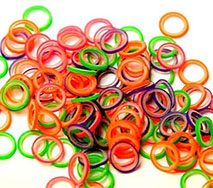
Wearing elastics (or rubber bands) during treatment is often required, and improves the co-ordination of your upper and lower teeth. Elastics can be coloured or neutral and latex free if required. Wearing rubber bands as instructed is very important and they work far more efficiently if worn as prescribed!
Headgear is often used to correct an excessive “overbite”, with the upper jaw forward of the lower jaw. This is done by placing pressure against the upper teeth and jaw, which would hold the teeth in position or help move them into better positions. The severity of the problem determines the length of time headgear needs to be worn. The key to success with your headgear appliance is consistency. Headgear must be worn a certain number of hours per day, and if not, it must be made up the following day.
Headgear should never be worn while playing sports and should also be removed while eating or brushing your teeth.
In some cases where an “underbite” is present, with the lower jaw forward of the upper jaw, we may recommend using reverse headgear (face mask) as part of the treatment plan. This appliance is designed to fix the discrepancy between your upper and lower jaws by moving the upper jaw forward to correct the malocclusion.
For the results to be successful, patient compliance is of the utmost importance. It may take several days to become accustomed to the appliance. With practice, it will become easier to place and remove the reverse headgear. We will determine the length of time you should wear your headgear, but it is generally 10-14 hours per day, which can include wearing while you sleep. You should not wear your headgear while participating in sporting activities.
Sometimes your chin may get irritated from the headgear. If this happens, you should always keep the area clean and often change the insert in the chin cup, or place a tissue with lotion folded in four in the cup. If the skin becomes very dry, the use of moisturizing cream twice a day can be helpful. If your jaw joints are extremely sore or you cannot open and close your mouth without difficulty, stop wearing the appliance and contact us for further instructions as we may need to fit you with a different appliance. Also, if your headgear breaks or is bent, call us so we can fit you in with a repair appointment so your treatment will not be delayed.
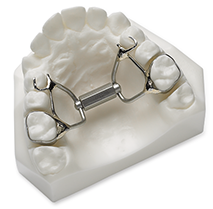
The Rapid Palatal Expander is an orthodontic device used to create a wider upper jaw, and is attached to the upper molars through bonding or by cemented bands. It is typically used when the upper jaw is too narrow for the lower jaw or when the upper teeth are crowded or blocked out of the dental arch.
When patients are still growing, the right and left halves of the upper jaw are not yet fused and very responsive to expansion. By simply activating the expander through turning a screw in the center of the palatal expander, with a special key we provide, gradual outward pressure is placed on the right and left halves of the upper jaw. This pressure causes an increased amount of bone to grow between the right and left halves of the jaw, ultimately resulting in an increased width. Once the desired expansion is achieved you will continue wearing the appliance for several months allowing the bone to fill in, and prevent relapse.
Have your child open his/her mouth as wide as possible. Place the wrench on the hex position of the middle cylinder of the expander so that the wrench is near the top teeth. Swing the wench down from the top teeth to meet the lower teeth. Turn the wrench over and repeat the swing. One swing equals to 0.2mm of expansion. Please follow the instructions of your orthodontist on the number of swings each day.
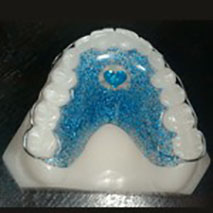
Retainers may be removable or fixed. They hold your teeth in their new, correct positions after your teeth have been straightened. Your orthodontist will instruct you on how to care for your retainer and about the duration of the wear. Wearing your retainer as directed is crucial to prevent relapse of your treatment.
Visit the retainers page to learn more on how to case for your retainer
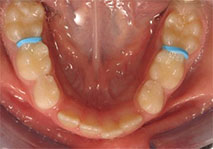
Separators are little rubber doughnuts that are placed between your teeth to push them apart so that orthodontic bands may be placed during your next appointment. The separators stay in your mouth for 2-3 weeks, and are then removed before the bands are placed. Separators do not mix well with sticky foods, toothpicks, or floss.
One of the most common problems orthodontists treat is the discrepancy that occurs when the upper teeth protrude beyond the lower. Ordinarily, when we see a patient with the upper teeth protruding, we tend to think that the upper jaw and teeth are too far forward; but, more often than not, this condition is due to a small lower jaw that is further back than it should be. With these patients, we would like to encourage the lower jaw to catch up in growth, and appliances like the Twin Block or the Herbst appliance help this happen.
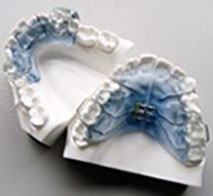
The Twin Block is a two-piece removable appliance that utilizes acrylic blocks formed in conjunction to position the mandible forward, and improve forward growth of the lower jaw.
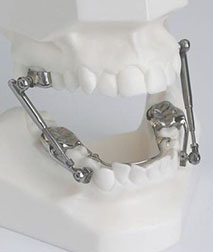
The Herbst appliance is a fixed appliance that positions the lower jaw in a more forward position. Even though the Herbst appliance prevents the lower jaw from moving backward, opening and closing movement still occur easily, and patients do not have any problems learning to chew their food with their lower jaw in this new position.
Patients with Herbst appliances need to be careful about what they eat. For instance, cold foods such as ice slushes, Popsicles and ice will freeze the cement and make the bands loosen. Sticky foods such as caramels, bubble gum and candy suckers will pull the bands away from the teeth. Hard foods like crisp vegetables and hard candies will bend and loosen the Herbst appliance, too. So stay away from these foods during your orthodontic treatment.
Your Herbst appliance will be checked and adjusted at your appointments. If, sometimes between appointments, you develop some sore areas on the inside of your cheeks, please do not try to adjust the appliance yourself. Call for an appointment so that the necessary adjustments can be made.
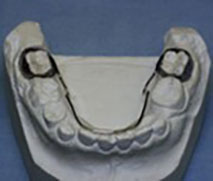
space maintainer is used to keep the permanent molars from drifting forward, and provide extra space for the permanent teeth in the presence of crowding. This appliance is commonly used in cases of premature loss of baby tooth or when the lower teeth of a growing child are slightly crowded and no permanent teeth are extracted to correct the problem.
Brushing and flossing daily is very important. Be sure to clean around the bands that are connected to the molars and the wire on the tongue side. This will prevent the formation of cavities or infection of the gums.
The duration of wear varies. We will monitor the eruption of new teeth and make adjustments as needed. Generally, a holding arch is removed following the eruption of all the permanent teeth.